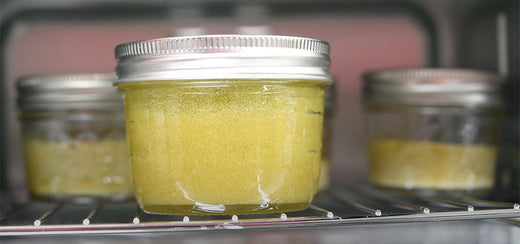How to Cure Rosin - Cold Curing vs Heat Curing

Rosin is often cured post-extraction to express the terpenes in a unique way, achieve specific textures, and extend the rosin’s shelf life at room temperature. "Curing rosin" means keeping rosin in a sealed glass jar at cool or warm temperatures for a few hours to a few days until the desired texture is achieved. Some people also whip their rosin before or after the curing process.
Mechanical techniques can be used to achieve some of the same outcomes as rosin curing—THCA separation can be achieved with additional rounds of pressing, for example. However, the beauty of rosin curing techniques is that they require minimal effort (only time) and are highly effective at achieving consistencies as diverse as badder, jam, sauce, and diamonds.
Why Cure Rosin?
The main reasons for curing rosin are to express the terpenes in a unique way, make the end product more shelf-stable at room temperature, and create a wider range of textures and consistencies than can be achieved with pressing alone. While you can technically dab rosin as soon as it flows out of the rosin press, curing allows you to create a complete line of products from a single concentrate (rosin) and potentially enhance the experience for the consumer.
Differences Between Cold vs Heat Curing
There are two main ways to cure cannabis rosin: cold curing and warm curing (or "heat curing"). Cold curing results in a wet badder consistency and maximum terpene preservation whereas heat curing can be used to create unique textures like diamonds, sauce, and jam.
Texture and Consistency
Cold curing is typically used with solventless hash rosin or flower rosin. It’s the most common curing method because the resulting wet badder consistency is great for marketing and shelf appeal.
Warm cures are often used with rosin made from bubble hash or dry sift. While slightly less common, heat curing is still very valuable (and important) because it’s the only way to make rosin jam and is one of the easiest ways to make sauce and diamonds.
Terpene Preservation
Cold curing is considered superior to heat curing in terms of terpene preservation because it doesn't raise the rosin above 70 °F. This is the temperature at which some terpenes begin to evaporate.
Heat curing is typically done at temperatures between 90 °F and 225 °F, which is sufficient to cause some terpenes to become volatile. However, as long as the lid remains sealed, terpene preservation in this range is still very good.
Equipment Required
Cold curing can be performed with very basic equipment: a sealable jar and possibly a refrigerator. Heat curing requires more specialized equipment: heat-proof glass jars, an oven, and a heated plate.
Whereas cold curing is very straightforward and comes with virtually no risks, heat curing requires regular monitoring because rosin left at high temperatures for too long could reduce to the point that it burns.
How Rosin Curing Works
During the curing process, the rosin nucleates. Nucleation refers to the beginning of a new thermodynamic phase in which crystal-like structures form inside a “metastable parent phase” such as a solution, liquid, or vapor. This process leads to the rosin "sugaring up" or "buddering up." Due to the formation of structures in the rosin, the terpenes are typically pushed to the top. When stirred back in, the terpenes can enhance the smell and create a wet-looking texture that is appealing to most consumers.
How to Cold Cure Rosin

To cold cure rosin, you'll typically store the jarred extract at room temp or in a refrigerator. We recommend the following process for cold curing rosin:
- Scrape the rosin off the parchment paper with a collection tool.
- Add the rosin to the jar and seal the jar. We recommend using UV-resistant jars to minimize light exposure. At a minimum, store the jar in a dark place.
- Keep the rosin at room temperature (60 °F to 70 °F) for a few weeks and check it every 24 hours to monitor the nucleation process. Alternatively, you can put it in the fridge or a wine cooler at 40 °F for 2-7 days and then store it at room temperature for a few weeks.
- Once you observe a layer of terpenes on top of the nucleated rosin, whip the rosin to homogenize the extract.
- Store your cured rosin in the refrigerator once it has reached the desired consistency.
How to Heat Cure Rosin

Heat curing or warm curing occurs at temperatures between 90 °F and 225 °F. Terpene degradation in this range is minimal (as long as the jar is sealed) and you can create sought-after textures like diamonds in sauce and rosin jam.
To heat-cure rosin, you'll need heat-resistant glass jars, an oven, and a heating pad. The process is as follows:
- Transfer the rosin to a jar using a collection tool and seal the jar.
- Place the sealed jar in the oven at temperatures of 90 °F to 225 °F for 30 minutes to a few hours. Then transfer it to the heat mat for a few days to a week.
- After curing, store your rosin in the fridge for short-term storage (1 month) or in the freezer for long-term storage (longer than a month).
Important notes for warm curing:
- Keep the lid of the jar sealed at all times to minimize terpene loss and oxidation.
- Don't agitate the rosin during the heat curing process.
Rosin Curing Tips
There are a few additional tricks for getting the best out of your cured rosin—especially if you plan to market it to consumers.

- Begin with premium hash rosin made from trichome-rich cannabis strains.The depth of flavor you can achieve with rosin cures is directly related to the quality of your starting material.
- Experiment with a range of different strains, curing temperatures, curing times, and whipping frequency. Document the parameters you use for each batch to help you refine your technique and replicate your best results.
- Use straight jars rather than jars that are narrow at the top. This makes it easier to remove the cured rosin from the jar for gramming out, packaging, and distribution.
- Don't leave too much space in the top of the jar when using Jar Tech. We recommend not exceeding 80% of the jar's capacity.
- Check your rosin every 24 hours for cold curing and every 30 minutes for heat curing until the desired consistency is achieved. Stir it if the terpenes have separated.
- Let refrigerated jars sit at room temperature for 20 minutes before opening them to prevent unwanted moisture from entering the jar and causing mold and microbial growth. When you open the lid, wipe away any moisture around the inside of the opening to prevent it from falling onto the rosin.
Diversify Your Offerings With Rosin Curing
Curing rosin enhances the gourmet palette of rosin by adding depth and subtlety to the flavor. For extraction businesses, curing enables you to turn a single product—rosin—into an entire line of lucrative SKUs.
As you begin to experiment, remember that the quality of your starting material is key for excellent results no matter which curing process you use. Creating textures and flavors that will wow your customers is then simply a matter of experimenting until you strike gold.



